Analyzing Big Data: Impact, Evolution, and Future of Banking
VerifiedAdded on 2023/03/23
|7
|1521
|78
Report
AI Summary
This report delves into the transformative impact of big data analytics on the banking industry. It explores the evolution of data analytics, its current applications, and its future potential within the sector. The report highlights how banks leverage big data for various purposes, including understanding consumer behavior, assessing investment risks, identifying fraudulent activities, and personalizing customer experiences. It also examines how big data has disrupted traditional banking operations through innovations like mobile banking and blockchain technology. Furthermore, the report discusses the organizational roles associated with big data analytics, such as fraud detection and customer transaction analysis, and the increasing demand for data analytics professionals. The author expresses a strong interest in a data analytics management role, emphasizing the advantages of data-driven innovation and individual-level protection within the banking industry. The report concludes by referencing several academic sources that support the analysis.
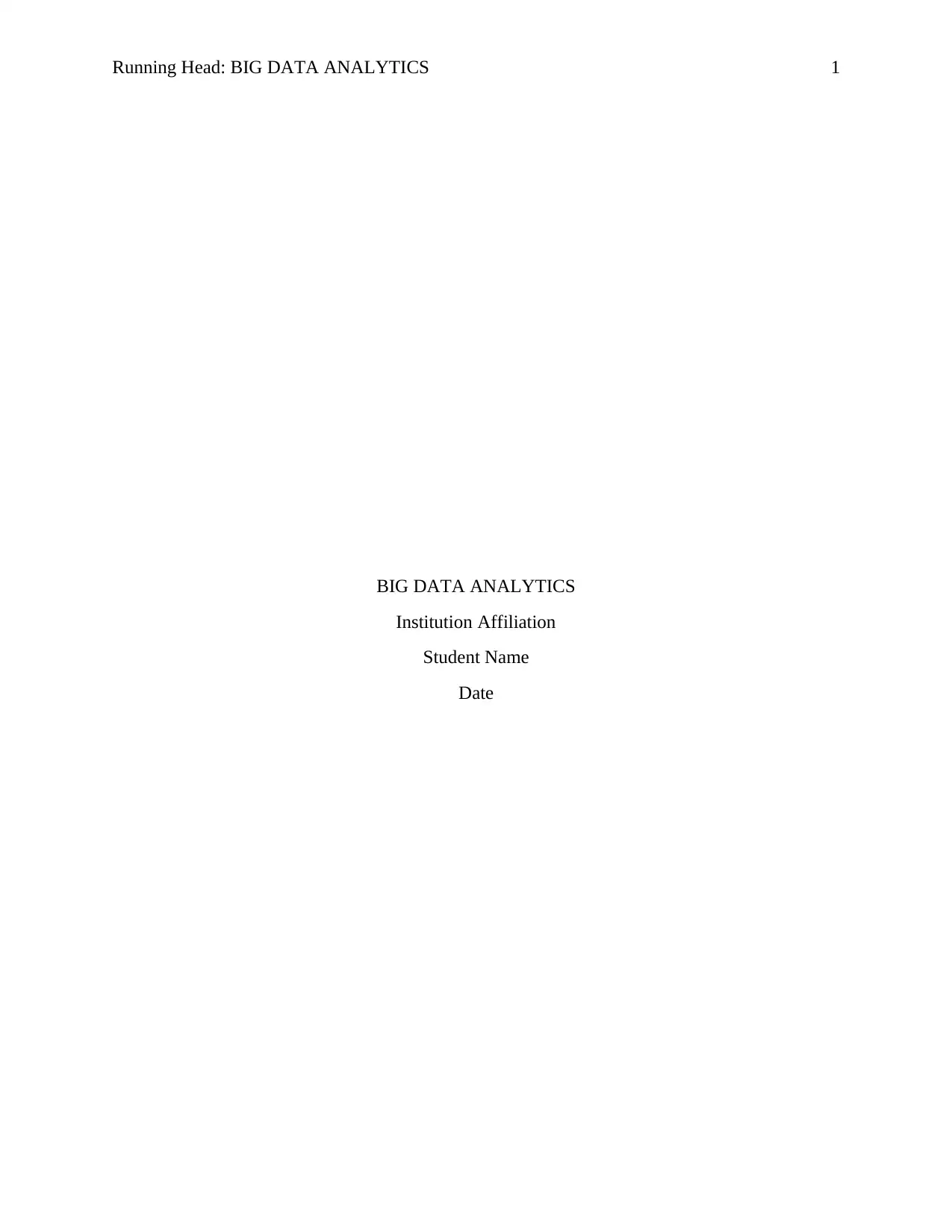
Running Head: BIG DATA ANALYTICS 1
BIG DATA ANALYTICS
Institution Affiliation
Student Name
Date
BIG DATA ANALYTICS
Institution Affiliation
Student Name
Date
Paraphrase This Document
Need a fresh take? Get an instant paraphrase of this document with our AI Paraphraser
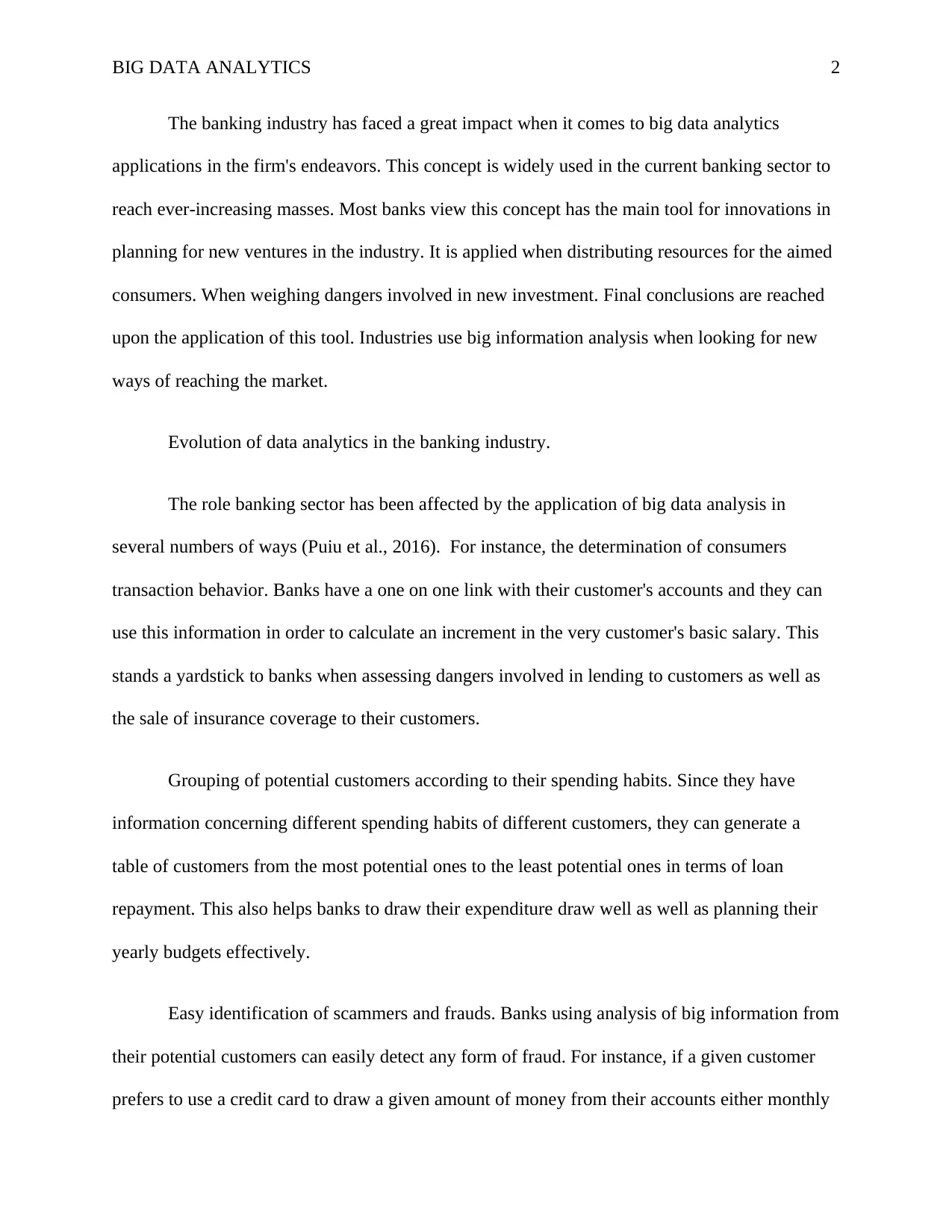
BIG DATA ANALYTICS 2
The banking industry has faced a great impact when it comes to big data analytics
applications in the firm's endeavors. This concept is widely used in the current banking sector to
reach ever-increasing masses. Most banks view this concept has the main tool for innovations in
planning for new ventures in the industry. It is applied when distributing resources for the aimed
consumers. When weighing dangers involved in new investment. Final conclusions are reached
upon the application of this tool. Industries use big information analysis when looking for new
ways of reaching the market.
Evolution of data analytics in the banking industry.
The role banking sector has been affected by the application of big data analysis in
several numbers of ways (Puiu et al., 2016). For instance, the determination of consumers
transaction behavior. Banks have a one on one link with their customer's accounts and they can
use this information in order to calculate an increment in the very customer's basic salary. This
stands a yardstick to banks when assessing dangers involved in lending to customers as well as
the sale of insurance coverage to their customers.
Grouping of potential customers according to their spending habits. Since they have
information concerning different spending habits of different customers, they can generate a
table of customers from the most potential ones to the least potential ones in terms of loan
repayment. This also helps banks to draw their expenditure draw well as well as planning their
yearly budgets effectively.
Easy identification of scammers and frauds. Banks using analysis of big information from
their potential customers can easily detect any form of fraud. For instance, if a given customer
prefers to use a credit card to draw a given amount of money from their accounts either monthly
The banking industry has faced a great impact when it comes to big data analytics
applications in the firm's endeavors. This concept is widely used in the current banking sector to
reach ever-increasing masses. Most banks view this concept has the main tool for innovations in
planning for new ventures in the industry. It is applied when distributing resources for the aimed
consumers. When weighing dangers involved in new investment. Final conclusions are reached
upon the application of this tool. Industries use big information analysis when looking for new
ways of reaching the market.
Evolution of data analytics in the banking industry.
The role banking sector has been affected by the application of big data analysis in
several numbers of ways (Puiu et al., 2016). For instance, the determination of consumers
transaction behavior. Banks have a one on one link with their customer's accounts and they can
use this information in order to calculate an increment in the very customer's basic salary. This
stands a yardstick to banks when assessing dangers involved in lending to customers as well as
the sale of insurance coverage to their customers.
Grouping of potential customers according to their spending habits. Since they have
information concerning different spending habits of different customers, they can generate a
table of customers from the most potential ones to the least potential ones in terms of loan
repayment. This also helps banks to draw their expenditure draw well as well as planning their
yearly budgets effectively.
Easy identification of scammers and frauds. Banks using analysis of big information from
their potential customers can easily detect any form of fraud. For instance, if a given customer
prefers to use a credit card to draw a given amount of money from their accounts either monthly
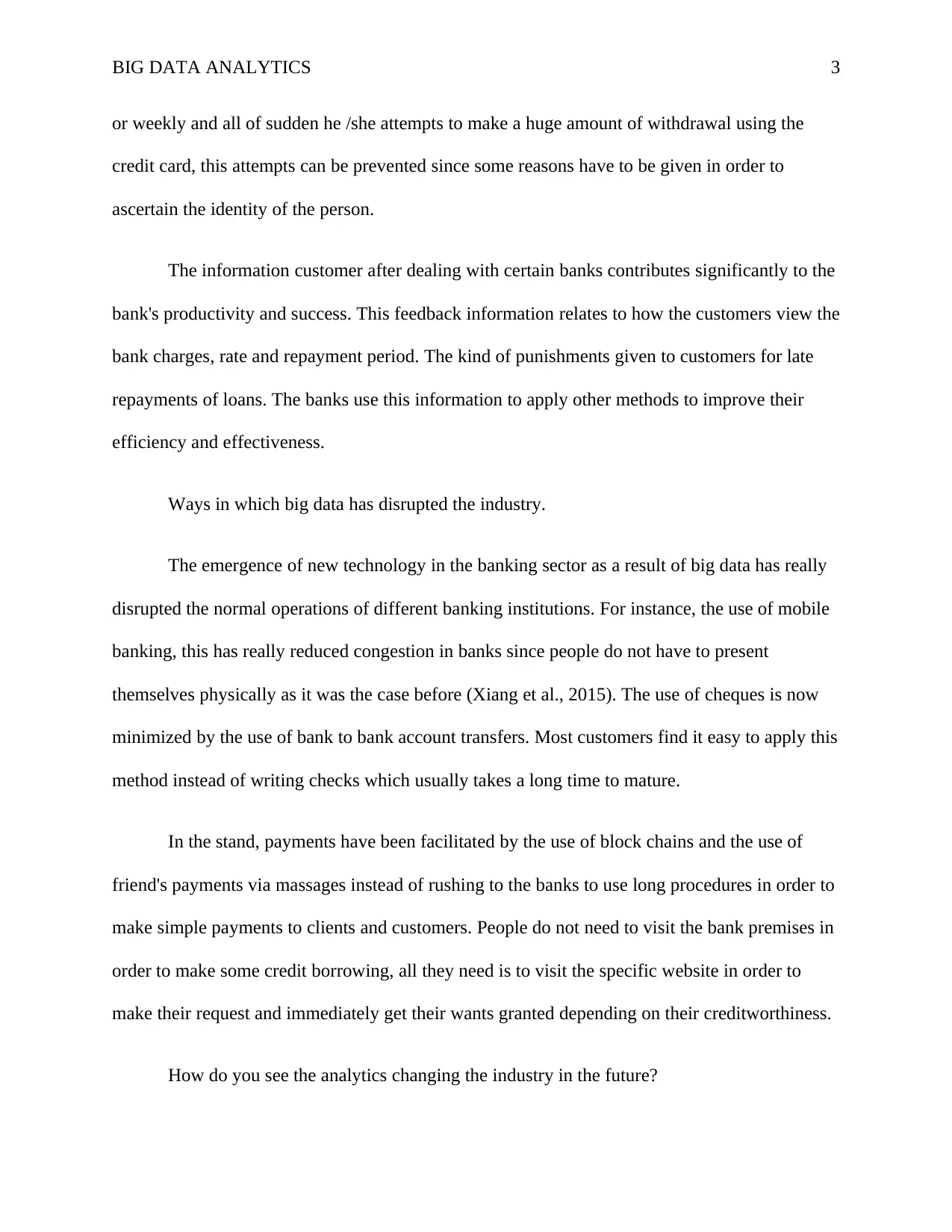
BIG DATA ANALYTICS 3
or weekly and all of sudden he /she attempts to make a huge amount of withdrawal using the
credit card, this attempts can be prevented since some reasons have to be given in order to
ascertain the identity of the person.
The information customer after dealing with certain banks contributes significantly to the
bank's productivity and success. This feedback information relates to how the customers view the
bank charges, rate and repayment period. The kind of punishments given to customers for late
repayments of loans. The banks use this information to apply other methods to improve their
efficiency and effectiveness.
Ways in which big data has disrupted the industry.
The emergence of new technology in the banking sector as a result of big data has really
disrupted the normal operations of different banking institutions. For instance, the use of mobile
banking, this has really reduced congestion in banks since people do not have to present
themselves physically as it was the case before (Xiang et al., 2015). The use of cheques is now
minimized by the use of bank to bank account transfers. Most customers find it easy to apply this
method instead of writing checks which usually takes a long time to mature.
In the stand, payments have been facilitated by the use of block chains and the use of
friend's payments via massages instead of rushing to the banks to use long procedures in order to
make simple payments to clients and customers. People do not need to visit the bank premises in
order to make some credit borrowing, all they need is to visit the specific website in order to
make their request and immediately get their wants granted depending on their creditworthiness.
How do you see the analytics changing the industry in the future?
or weekly and all of sudden he /she attempts to make a huge amount of withdrawal using the
credit card, this attempts can be prevented since some reasons have to be given in order to
ascertain the identity of the person.
The information customer after dealing with certain banks contributes significantly to the
bank's productivity and success. This feedback information relates to how the customers view the
bank charges, rate and repayment period. The kind of punishments given to customers for late
repayments of loans. The banks use this information to apply other methods to improve their
efficiency and effectiveness.
Ways in which big data has disrupted the industry.
The emergence of new technology in the banking sector as a result of big data has really
disrupted the normal operations of different banking institutions. For instance, the use of mobile
banking, this has really reduced congestion in banks since people do not have to present
themselves physically as it was the case before (Xiang et al., 2015). The use of cheques is now
minimized by the use of bank to bank account transfers. Most customers find it easy to apply this
method instead of writing checks which usually takes a long time to mature.
In the stand, payments have been facilitated by the use of block chains and the use of
friend's payments via massages instead of rushing to the banks to use long procedures in order to
make simple payments to clients and customers. People do not need to visit the bank premises in
order to make some credit borrowing, all they need is to visit the specific website in order to
make their request and immediately get their wants granted depending on their creditworthiness.
How do you see the analytics changing the industry in the future?
⊘ This is a preview!⊘
Do you want full access?
Subscribe today to unlock all pages.

Trusted by 1+ million students worldwide
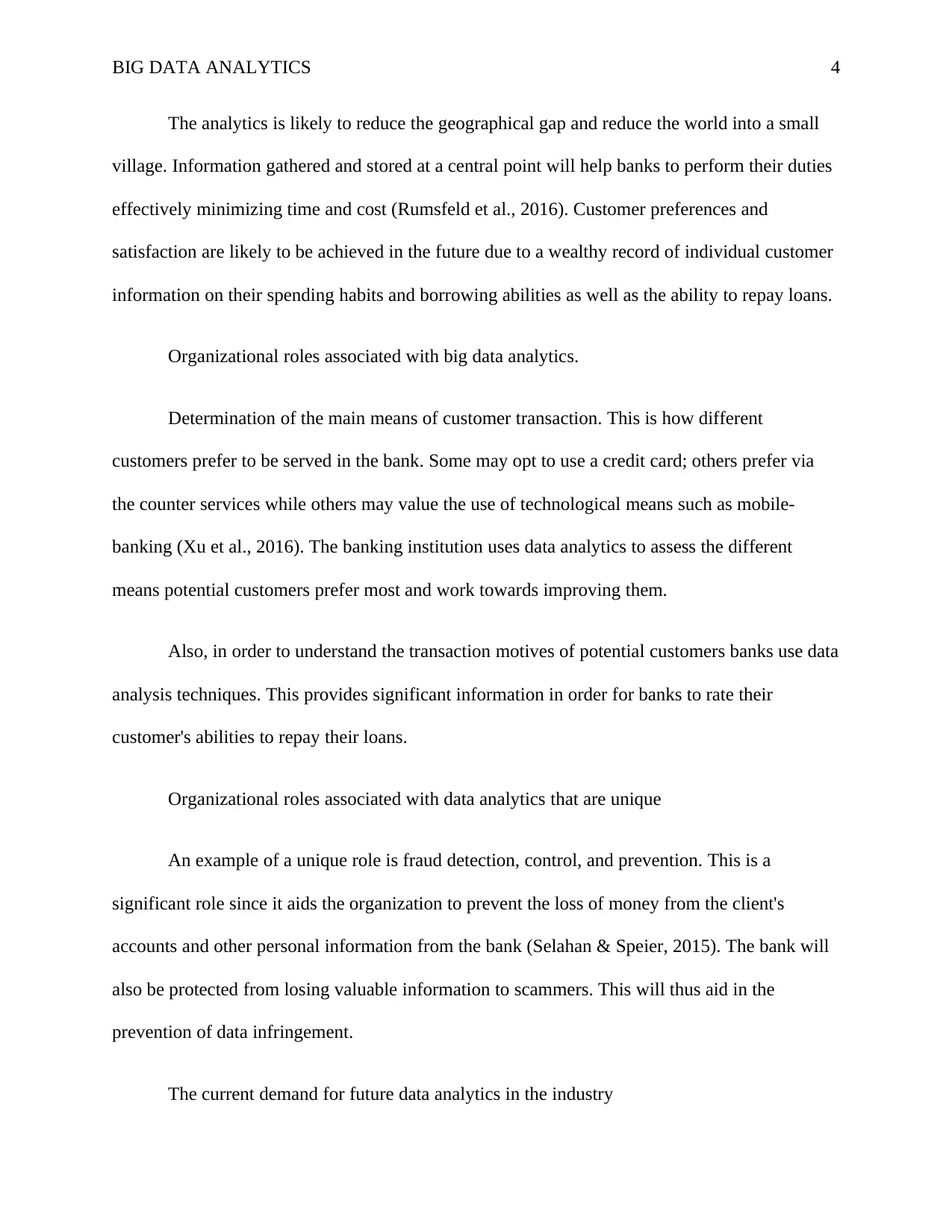
BIG DATA ANALYTICS 4
The analytics is likely to reduce the geographical gap and reduce the world into a small
village. Information gathered and stored at a central point will help banks to perform their duties
effectively minimizing time and cost (Rumsfeld et al., 2016). Customer preferences and
satisfaction are likely to be achieved in the future due to a wealthy record of individual customer
information on their spending habits and borrowing abilities as well as the ability to repay loans.
Organizational roles associated with big data analytics.
Determination of the main means of customer transaction. This is how different
customers prefer to be served in the bank. Some may opt to use a credit card; others prefer via
the counter services while others may value the use of technological means such as mobile-
banking (Xu et al., 2016). The banking institution uses data analytics to assess the different
means potential customers prefer most and work towards improving them.
Also, in order to understand the transaction motives of potential customers banks use data
analysis techniques. This provides significant information in order for banks to rate their
customer's abilities to repay their loans.
Organizational roles associated with data analytics that are unique
An example of a unique role is fraud detection, control, and prevention. This is a
significant role since it aids the organization to prevent the loss of money from the client's
accounts and other personal information from the bank (Selahan & Speier, 2015). The bank will
also be protected from losing valuable information to scammers. This will thus aid in the
prevention of data infringement.
The current demand for future data analytics in the industry
The analytics is likely to reduce the geographical gap and reduce the world into a small
village. Information gathered and stored at a central point will help banks to perform their duties
effectively minimizing time and cost (Rumsfeld et al., 2016). Customer preferences and
satisfaction are likely to be achieved in the future due to a wealthy record of individual customer
information on their spending habits and borrowing abilities as well as the ability to repay loans.
Organizational roles associated with big data analytics.
Determination of the main means of customer transaction. This is how different
customers prefer to be served in the bank. Some may opt to use a credit card; others prefer via
the counter services while others may value the use of technological means such as mobile-
banking (Xu et al., 2016). The banking institution uses data analytics to assess the different
means potential customers prefer most and work towards improving them.
Also, in order to understand the transaction motives of potential customers banks use data
analysis techniques. This provides significant information in order for banks to rate their
customer's abilities to repay their loans.
Organizational roles associated with data analytics that are unique
An example of a unique role is fraud detection, control, and prevention. This is a
significant role since it aids the organization to prevent the loss of money from the client's
accounts and other personal information from the bank (Selahan & Speier, 2015). The bank will
also be protected from losing valuable information to scammers. This will thus aid in the
prevention of data infringement.
The current demand for future data analytics in the industry
Paraphrase This Document
Need a fresh take? Get an instant paraphrase of this document with our AI Paraphraser
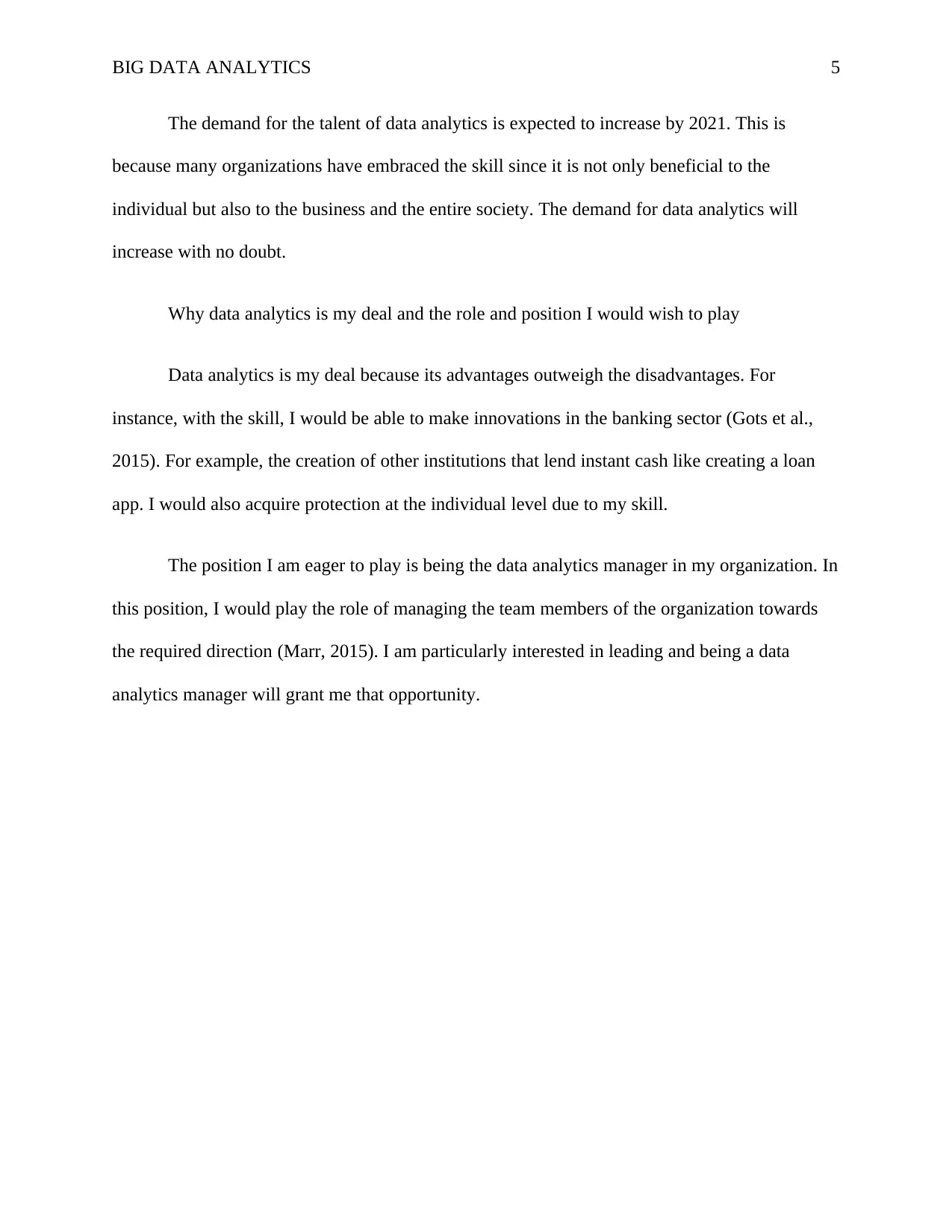
BIG DATA ANALYTICS 5
The demand for the talent of data analytics is expected to increase by 2021. This is
because many organizations have embraced the skill since it is not only beneficial to the
individual but also to the business and the entire society. The demand for data analytics will
increase with no doubt.
Why data analytics is my deal and the role and position I would wish to play
Data analytics is my deal because its advantages outweigh the disadvantages. For
instance, with the skill, I would be able to make innovations in the banking sector (Gots et al.,
2015). For example, the creation of other institutions that lend instant cash like creating a loan
app. I would also acquire protection at the individual level due to my skill.
The position I am eager to play is being the data analytics manager in my organization. In
this position, I would play the role of managing the team members of the organization towards
the required direction (Marr, 2015). I am particularly interested in leading and being a data
analytics manager will grant me that opportunity.
The demand for the talent of data analytics is expected to increase by 2021. This is
because many organizations have embraced the skill since it is not only beneficial to the
individual but also to the business and the entire society. The demand for data analytics will
increase with no doubt.
Why data analytics is my deal and the role and position I would wish to play
Data analytics is my deal because its advantages outweigh the disadvantages. For
instance, with the skill, I would be able to make innovations in the banking sector (Gots et al.,
2015). For example, the creation of other institutions that lend instant cash like creating a loan
app. I would also acquire protection at the individual level due to my skill.
The position I am eager to play is being the data analytics manager in my organization. In
this position, I would play the role of managing the team members of the organization towards
the required direction (Marr, 2015). I am particularly interested in leading and being a data
analytics manager will grant me that opportunity.
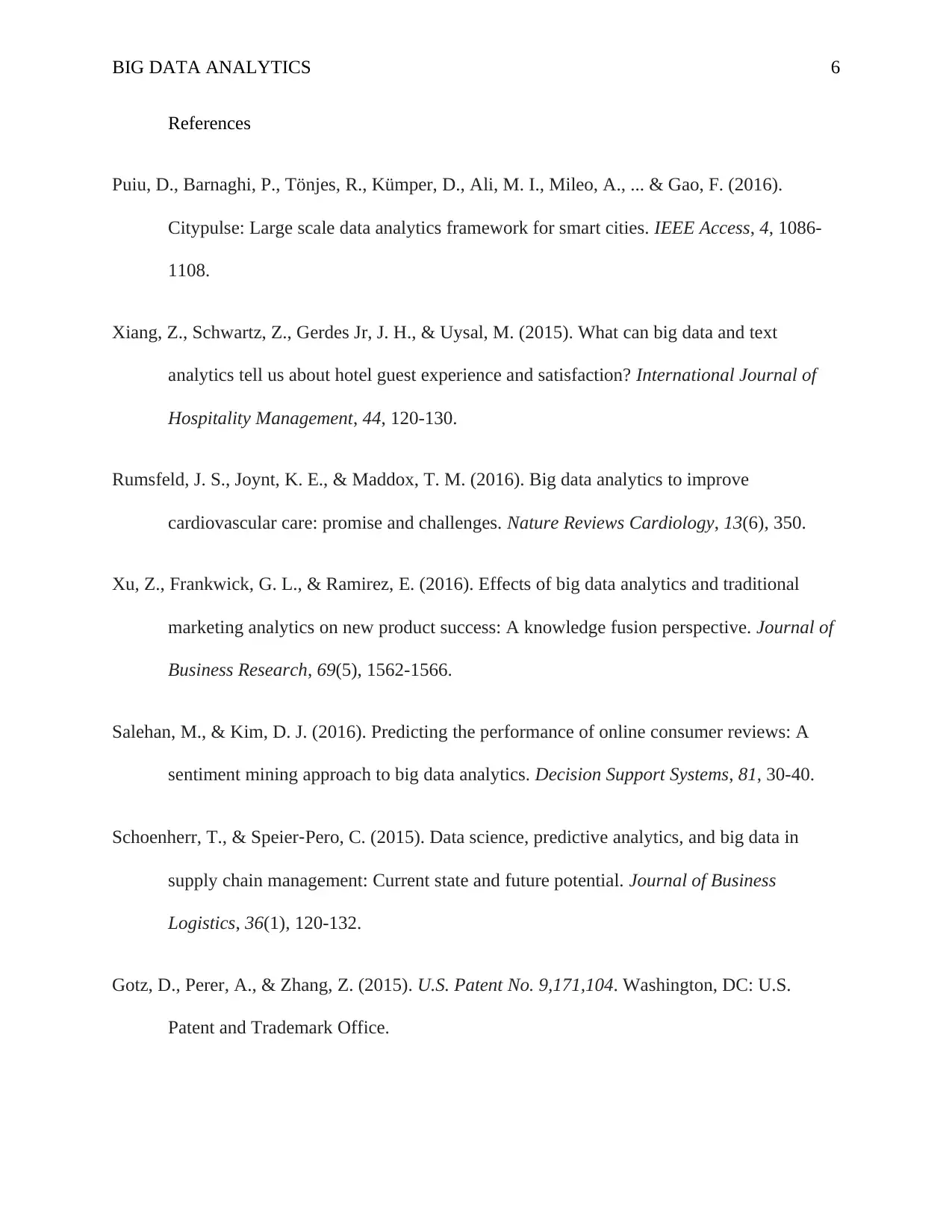
BIG DATA ANALYTICS 6
References
Puiu, D., Barnaghi, P., Tönjes, R., Kümper, D., Ali, M. I., Mileo, A., ... & Gao, F. (2016).
Citypulse: Large scale data analytics framework for smart cities. IEEE Access, 4, 1086-
1108.
Xiang, Z., Schwartz, Z., Gerdes Jr, J. H., & Uysal, M. (2015). What can big data and text
analytics tell us about hotel guest experience and satisfaction? International Journal of
Hospitality Management, 44, 120-130.
Rumsfeld, J. S., Joynt, K. E., & Maddox, T. M. (2016). Big data analytics to improve
cardiovascular care: promise and challenges. Nature Reviews Cardiology, 13(6), 350.
Xu, Z., Frankwick, G. L., & Ramirez, E. (2016). Effects of big data analytics and traditional
marketing analytics on new product success: A knowledge fusion perspective. Journal of
Business Research, 69(5), 1562-1566.
Salehan, M., & Kim, D. J. (2016). Predicting the performance of online consumer reviews: A
sentiment mining approach to big data analytics. Decision Support Systems, 81, 30-40.
Schoenherr, T., & Speier‐Pero, C. (2015). Data science, predictive analytics, and big data in
supply chain management: Current state and future potential. Journal of Business
Logistics, 36(1), 120-132.
Gotz, D., Perer, A., & Zhang, Z. (2015). U.S. Patent No. 9,171,104. Washington, DC: U.S.
Patent and Trademark Office.
References
Puiu, D., Barnaghi, P., Tönjes, R., Kümper, D., Ali, M. I., Mileo, A., ... & Gao, F. (2016).
Citypulse: Large scale data analytics framework for smart cities. IEEE Access, 4, 1086-
1108.
Xiang, Z., Schwartz, Z., Gerdes Jr, J. H., & Uysal, M. (2015). What can big data and text
analytics tell us about hotel guest experience and satisfaction? International Journal of
Hospitality Management, 44, 120-130.
Rumsfeld, J. S., Joynt, K. E., & Maddox, T. M. (2016). Big data analytics to improve
cardiovascular care: promise and challenges. Nature Reviews Cardiology, 13(6), 350.
Xu, Z., Frankwick, G. L., & Ramirez, E. (2016). Effects of big data analytics and traditional
marketing analytics on new product success: A knowledge fusion perspective. Journal of
Business Research, 69(5), 1562-1566.
Salehan, M., & Kim, D. J. (2016). Predicting the performance of online consumer reviews: A
sentiment mining approach to big data analytics. Decision Support Systems, 81, 30-40.
Schoenherr, T., & Speier‐Pero, C. (2015). Data science, predictive analytics, and big data in
supply chain management: Current state and future potential. Journal of Business
Logistics, 36(1), 120-132.
Gotz, D., Perer, A., & Zhang, Z. (2015). U.S. Patent No. 9,171,104. Washington, DC: U.S.
Patent and Trademark Office.
⊘ This is a preview!⊘
Do you want full access?
Subscribe today to unlock all pages.

Trusted by 1+ million students worldwide
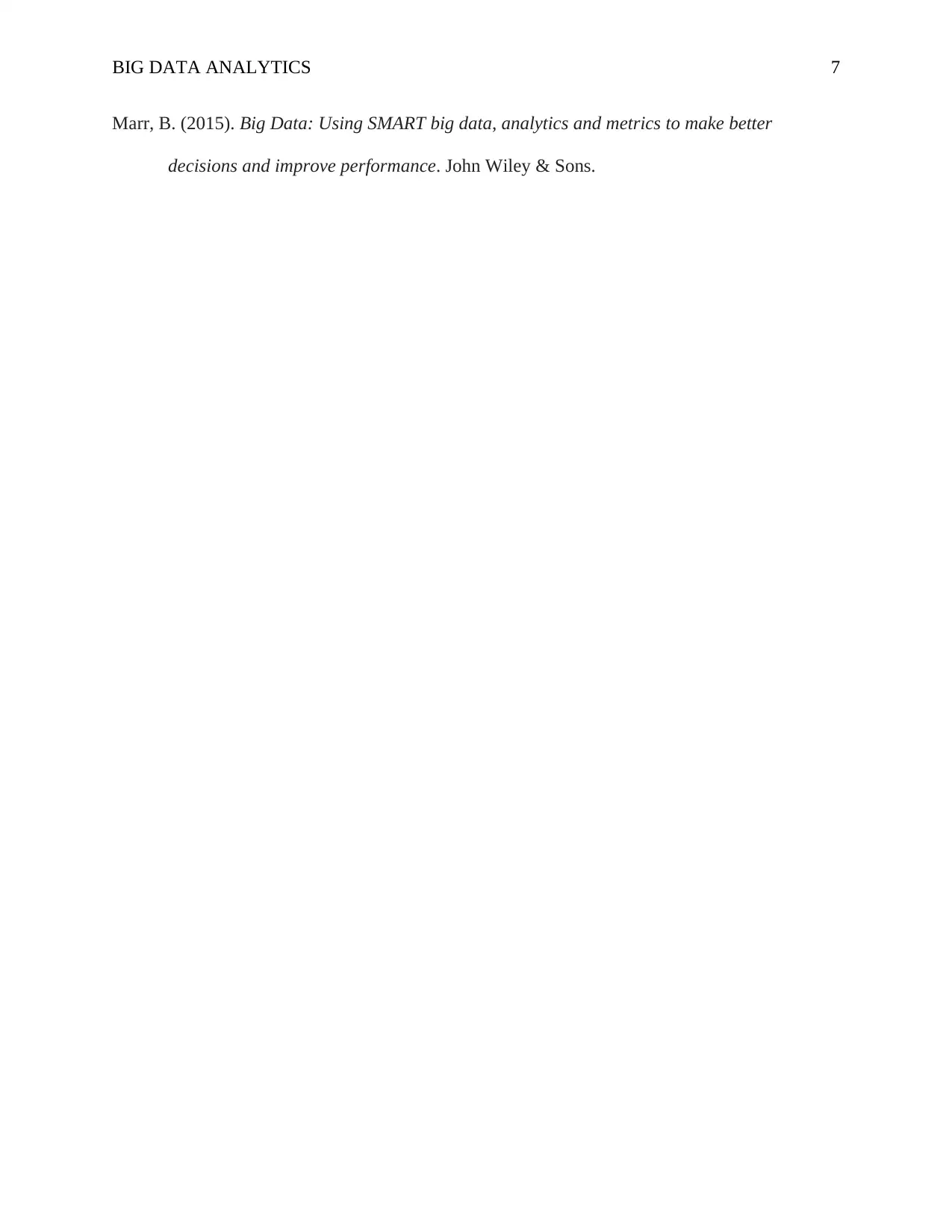
BIG DATA ANALYTICS 7
Marr, B. (2015). Big Data: Using SMART big data, analytics and metrics to make better
decisions and improve performance. John Wiley & Sons.
Marr, B. (2015). Big Data: Using SMART big data, analytics and metrics to make better
decisions and improve performance. John Wiley & Sons.
1 out of 7
Related Documents
Your All-in-One AI-Powered Toolkit for Academic Success.
+13062052269
info@desklib.com
Available 24*7 on WhatsApp / Email
![[object Object]](/_next/static/media/star-bottom.7253800d.svg)
Unlock your academic potential
Copyright © 2020–2025 A2Z Services. All Rights Reserved. Developed and managed by ZUCOL.





